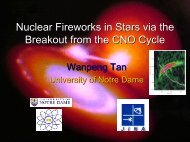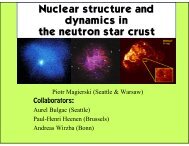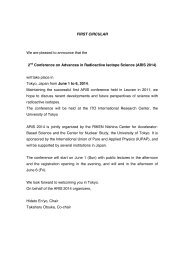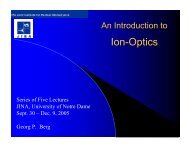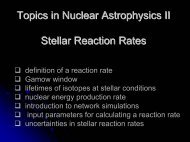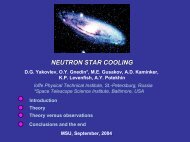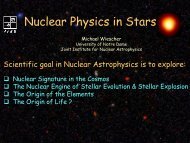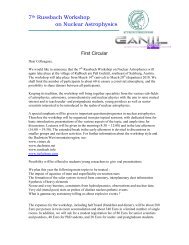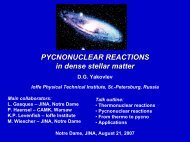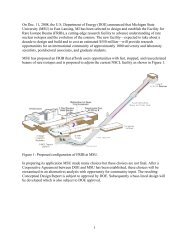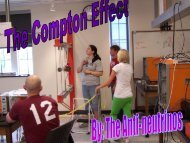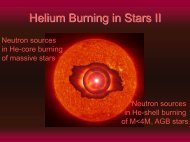Nuclear Astrophysics @ Notre Dame
Nuclear Astrophysics @ Notre Dame
Nuclear Astrophysics @ Notre Dame
You also want an ePaper? Increase the reach of your titles
YUMPU automatically turns print PDFs into web optimized ePapers that Google loves.
<strong>Nuclear</strong> <strong>Astrophysics</strong> at <strong>Notre</strong> <strong>Dame</strong><br />
Michael Wiescher<br />
University of <strong>Notre</strong> <strong>Dame</strong><br />
Questions in <strong>Nuclear</strong> <strong>Astrophysics</strong><br />
Experimental Facilities at <strong>Notre</strong> <strong>Dame</strong><br />
Experiments for CNO hydrogen burning<br />
Experiments for stellar helium burning<br />
New techniques for p-process experiments
Goals in experimental<br />
<strong>Nuclear</strong> <strong>Astrophysics</strong><br />
Identify nuclear probes (branching, bottleneck or waiting points)<br />
for determining site specific stellar conditions<br />
stellar evolution processes (H-, He-, C- ... burning)<br />
s-process<br />
(AGB & RGB stars)<br />
rp-process<br />
(novae and XRBs)<br />
Determine global nuclear characteristics (masses, decay<br />
properties, ...) to identify reaction path, determine & probe site<br />
p-process (type I or type II SN ...?)<br />
r-process (type II SN, neutron star mergers, jets ...?)<br />
ν-process (type II SN ....?)
Current challenges<br />
and future facilities<br />
nucleosynthesis in stellar evolution<br />
experiments at low energies ⇒ LENA, LUNA, NSL, UoW …<br />
DUSEL<br />
nucleosynthesis with neutrons<br />
experiments with high n-flux ⇒ FZKarlsruhe, LANSCE<br />
n-ToF, ORELA, SNS<br />
nucleosynthesis in stellar explosion<br />
experiments far of stability ⇒ ANL, HRIBF, ISAC, LLN,<br />
NSCL, RIKEN, REX,<br />
FAIR-GSI, RIA …
Participants in the experimental program in<br />
<strong>Nuclear</strong> <strong>Astrophysics</strong> @ <strong>Notre</strong> <strong>Dame</strong><br />
Research Personnel<br />
Manoel Couder<br />
Joachim Görres<br />
Wolfgang Rapp<br />
Ed Stech<br />
Wan Peng Tan<br />
Michael Wiescher<br />
11 Graduate Students<br />
➱<br />
➱<br />
➱<br />
➱<br />
Mary Beard<br />
Aaron Couture<br />
Jason Daly<br />
Michael Lamey<br />
Paul Le Blanc<br />
Hye-Young Lee<br />
Shawn O’Brien<br />
Annalia Palumbo<br />
Elisabeth Strandberg<br />
Barbara Truett<br />
Claudio Ugalde<br />
4 Undergraduate Students<br />
Nicholas Battafarano<br />
Christoph Bär<br />
James Marquez-Miller<br />
Edward Simpson
Experimental Facilities<br />
Low energy studies at local JN/KN accelerators<br />
Both accelerators have been installed and tested and are<br />
being operated by undergraduate and graduate students.<br />
The accelerators are used for low energy nuclear astrophysics<br />
measurements with focus on stellar hydrogen and helium burning.
Experimental Facilities<br />
Experiments at the FN tandem accelerator and the TwinSol facility<br />
Transfer, scattering, and reaction studies on nuclear astrophysics related topics<br />
p-process measurements in SN-II shock-front environments<br />
Reaction and structure studies for hot CNO and rp-process
Stellar Hydrogen Burning in Massive Stars<br />
Break-Out from the cold CNO cycles<br />
∆E G = 30 -120 keV<br />
Small leakage out of CNO cycle could lead to slow<br />
CNO fuel depletion in massive main sequence stars!
Measurement of 19 F(p,γ) 20 Ne<br />
Handicapped by pile up from strong<br />
19F(p,αγ) background at 6.125 MeV<br />
Single γ spectrum of<br />
the 669 keV resonance<br />
in 19 F(p,γ) 20 Ne
Experimental Sep-Up
Optimized detector design<br />
669 keV<br />
486 keV
Yield Curve for 19 F(p,αγ) and 19 F(p,γ)<br />
3-4 orders of magnitude<br />
difference in resonance yield
19<br />
F(p,γ) 20 Ne excitation curve &<br />
extrapolation to stellar energies<br />
Breit Wigner fit to resonances<br />
and direct capture is based on<br />
previous ωγ strength estimates
S-factor curve<br />
S(E)= σ(E)·E·e 2πη<br />
S 19 F(p,α)<br />
≈1500 MeV-barns<br />
∆E G = 30 -120 keV
Leakage from cold CNO cycles<br />
mass fraction X i<br />
time [s]<br />
time [s]<br />
Losses towards Ne-Na mass range are negligible<br />
Over the entire period of stellar hydrogen burning
Low energy study would provide answer for<br />
T-dependent n-flux for weak s-process<br />
Challenges in He-burning<br />
12<br />
C(α,γ) 16 O – a challenge since 40 years<br />
But also reactions like 18 O(α,γ) 22 Ne and<br />
e.g. 22 Ne(α,γ) 26 Mg, 22 Ne(α,n) 25 Mg<br />
Lack of low energy resonances!<br />
The lowest observed<br />
resonance is at<br />
E R ≈830keV, but<br />
more levels known<br />
…<br />
alpha cluster states
Neutron sources in stellar He burning<br />
Stellar He-burning, n-sources<br />
13<br />
C(α,n) 17 O, 13 C(α,α) 13 C<br />
Is presently being analyzed<br />
14<br />
N (α,γ) 18 F and 18 O (α,γ) 22 Ne<br />
have been completed<br />
Remaining question:<br />
22<br />
Ne(α,γ) 26 Mg<br />
22<br />
Ne(α,n) 25 Mg<br />
New attempt using<br />
the Rhinoceros gas<br />
target combined with<br />
improved detectors.
Questions in 22 Ne+α<br />
Strong low energy resonances<br />
in 22 Ne(α,n) but also strong low<br />
energy resonances in 22 Ne(α,γ)<br />
10.615 MeV<br />
22<br />
Ne+α<br />
11.093 MeV<br />
25<br />
Mg+n<br />
26<br />
Mg<br />
High 22 Ne(α,n) rate causes<br />
rapid conversion of 22 Ne to<br />
26<br />
Mg - 26 Mg(α,n) as n-source?
n-capture measurements at n-ToF<br />
Lead spallation target at CERN ps-booster<br />
ring white n-source with ~150 m flight path<br />
25<br />
Mg(n,γ) time of flight<br />
spectrum of n-unbound<br />
states in 26 Mg<br />
Several n-unbound states below the lowest resonance level<br />
in 22 Ne+α observed, more direct measurements are needed!
Future developments<br />
St. George Separator - STrong Gradient Electromagnetic Online Recoil<br />
separator for capture Gamma ray Experiments<br />
Background Reduction<br />
Inverse kinematics<br />
DUSEL underground<br />
Present accelerators<br />
need replacement<br />
with 6 MV Singletron<br />
Stable beam Accelerator for <strong>Nuclear</strong> <strong>Astrophysics</strong> (St. Ana)
0<br />
0 0.2 0.4 0.6 0.8 1<br />
TIME (s)<br />
p-process<br />
TEMPERATURE (T 9<br />
)<br />
High γ-flux in the O/Ne zone<br />
of pre-supernova star<br />
3<br />
2.5<br />
2<br />
1.5<br />
6<br />
1 0 0.2 0.4 0.6 0.8 1<br />
DENSITY (10 5 ×g/cm 2 )<br />
5<br />
4<br />
3<br />
2<br />
1
X SEED<br />
10 -3<br />
10 -4<br />
10 -5<br />
10 -6<br />
10 -7<br />
10 -8<br />
10 -9<br />
10 -10<br />
10 -11<br />
10 -12<br />
Conversion of the initial<br />
s-process abundance<br />
La (57)<br />
Ba (56)<br />
distribution to<br />
Cs (55)<br />
Xe (54)<br />
I (53)<br />
p-nuclei<br />
Te (52)<br />
Sb (51)<br />
Sn (50)<br />
In (49)<br />
Cd (48)<br />
50 75 100 125 150 175 200<br />
MASS NUMBER<br />
/F 0<br />
Pm (61)<br />
Nd (60)<br />
Pr (59)<br />
Ce (58)<br />
48 50 52 54 56 58 60 62 64 66 68<br />
10<br />
1<br />
0.1<br />
Dy (66)<br />
Tb (65)<br />
Gd (64)<br />
Eu (63)<br />
Sm (62)<br />
Se<br />
Kr<br />
Sr<br />
Mo<br />
83<br />
80 82<br />
79<br />
76 78<br />
75<br />
70 72 74<br />
Pd Cd In<br />
Ru<br />
Sn<br />
Sn<br />
Xe<br />
Te<br />
0.01<br />
60 80 100 120 140 160 180 200<br />
MASS NUMBER<br />
Ba<br />
Ce<br />
La<br />
Sm<br />
Gd<br />
98<br />
97<br />
94 96<br />
93<br />
92<br />
91<br />
86 88 90<br />
85<br />
84<br />
Dy<br />
Hf<br />
Yb Os<br />
Ta<br />
Er<br />
W<br />
Pt<br />
Hg<br />
Light p-Nuclei
The (γ,α) photodisintegration<br />
110<br />
Sn(γ,α) 106 Cd<br />
110<br />
Sn(γ,n) 109 Sn<br />
110<br />
Sn(γ,p) 109 In<br />
Rh (45)<br />
Ru (44)<br />
Tc (43)<br />
Mo (42)<br />
Nb (41)<br />
Zr (40)<br />
Y (39)<br />
Feeding of 92,94 Mo<br />
and 96,98 Ru?<br />
Sn (50)<br />
In (49)<br />
Cd (48)<br />
Ag (47)<br />
Pd (46)<br />
Sn (50)<br />
In (49)<br />
Cd (48)<br />
Ag (47)<br />
Pd (46)<br />
Rh (45)<br />
Ru (44)<br />
Tc (43)<br />
Mo (42)<br />
Nb (41)<br />
Zr (40)<br />
Y (39)<br />
75<br />
70 72 74<br />
69<br />
66 68<br />
65<br />
62 64<br />
61<br />
60<br />
59<br />
58<br />
57<br />
Increase of α threshold<br />
near Z,N=50 changes<br />
p-process flow pattern<br />
65<br />
67 69 71 73<br />
75
Measurement by Activation Technique<br />
106<br />
Cd(α,γ) 110 Sn; Q=1.258 MeV<br />
106<br />
Cd(α,n) 109 Sn; Q= - 10.144 MeV<br />
106<br />
Cd(α,p) 109 In; Q= -5.512 MeV<br />
E α = 8 -14 MeV
Two Ge-clover<br />
detector array<br />
Counting Facility
Excitation curves in comparison with<br />
Hauser Feshbach model predictions<br />
106<br />
Cd(α,γ) 110 Sn<br />
106<br />
Cd(α,n) 109 Sn<br />
106<br />
Cd(α,p) 109 In<br />
Considerable deviations between different<br />
HF models and observed cross sections.<br />
Future activities: p-process simulations defined key reactions<br />
Coulomb break-up on RIB p-nuclei<br />
(α,γ) on p-nuclei … AMS method
p-process simulations<br />
Variation of rates<br />
within factor 3<br />
Lu (71)<br />
Yb (70)<br />
Tm (69)<br />
Er (68)<br />
Ho (67)<br />
Dy (66)<br />
Tb (65)<br />
Gd (64)<br />
Eu (63)<br />
Sm (62)<br />
Ir (77)<br />
Os (76)<br />
Re (75)<br />
W (74)<br />
Ta (73)<br />
Hf (72)<br />
68 70 72 74 76 78 80 82 84 86 88 90 92<br />
Bi (83)<br />
Pb (82)<br />
Tl (81)<br />
Hg (80)<br />
Au (79)<br />
Pt (78)<br />
122 124<br />
121<br />
118 120<br />
117<br />
114 116<br />
113<br />
110 112<br />
109<br />
108<br />
107<br />
104 106<br />
103<br />
100 102<br />
99<br />
98<br />
97<br />
94 96<br />
127<br />
126<br />
125<br />
Impact of changes in (γ,α) rates<br />
mainly visible in upper mass range<br />
activation technique not possible
AMS technique<br />
Low-energy<br />
analysing<br />
magnet<br />
Tandem accelerator<br />
Stripper<br />
High-energy<br />
analysing<br />
magnet<br />
Negative ion source<br />
Electrostatic analyser<br />
Accelerator mass spectrometry<br />
∆<br />
E E<br />
If reaction products have no or<br />
only weak characteristic decay<br />
activity, AMS methods can be<br />
applied to separate (radioactive<br />
reaction products: examples:<br />
156<br />
Dy(α,γ) 160 Er or<br />
190<br />
Pt (α,γ) 160 Hg et al.
additional projects<br />
Spectroscopy of threshold levels with TwinSol 15 O (α,γ) 19 Ne<br />
Alpha cluster states in He-burning and αp-process<br />
neutron sources in SN shock-front<br />
Heavy ion fusion studies at sub-Coulomb energies 12 C+ 12 C<br />
Collaboration: ND, York (UK), Edinburgh (UK), ININ (Mexico)<br />
s-process branching points<br />
n-ToF collaboration<br />
Development of recoil separator St. George (JINA)<br />
Development of AMS for p-process (Collon)
Summary<br />
<strong>Nuclear</strong> <strong>Astrophysics</strong> projects at ND are focused on<br />
nucleosynthesis processes near stability:<br />
Stellar hydrogen burning in CNO and NeNa range<br />
Stellar helium burning (neutron sources)<br />
Novae, hot CNO cycles and αp-process<br />
p-process nucleosynthesis<br />
s-process nucleosynthesis (n-ToF)<br />
rp-process nucleosynthesis (LLN, NSCL)



